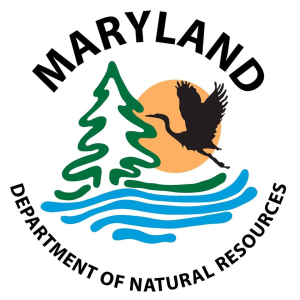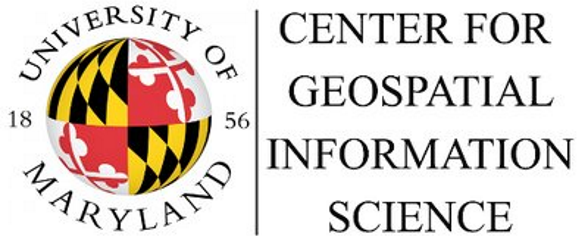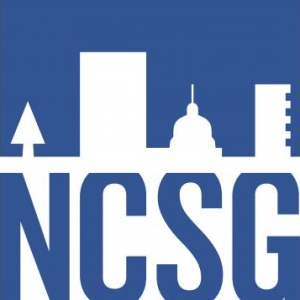About the Maryland EJScreen Mapper
This project was developed with support from: Maryland Department of Natural Resources (MD DNR), the National Oceanic & Atmospheric Administration (NOAA), University of Maryland Center for Geospatial Information Science (CGIS), the National Center for Smart Growth (NCSG) and University of Maryland School of Public Health Community Engagement, Environmental Justice & Health (CEEJH) lab.
MD EJSCORE
Each of the following categories contains a number of relevant indicators, and an averaged score. The two "Pollution Burden" average scores are then averaged together and the result is multiplied by the average of the "Population Characteristics" categories to get the total EJ Score of each tract. The total EJ Score is located on a seperate tab.
Population Burden and Population Characteristics
For the Population Burden and Population Characteristics data categories, because there are many different types of data with different units, directly comparing the raw values would be difficult. Instead, the percentile for each indicator is given. This shows the percentage of census tracts in Maryland that have a value less than equal to the tract selected. The values are given as a decimal from 0 to 1. A census tract with an "Asthma Emergency Discharges" value of .9 is therefore in the 90th percentile, which means only 10% of tracts in Maryland have higher values. EJ Scores near 1 represent areas of the greatest environmental justice concern.
The data for each indicator is classified in 5 bins:
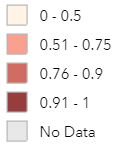
|
|---|
| 0 - 0.5: The score for this indicator is in the bottom half of the tracts in the state |
| 0.51 - 0.75: The score for this indicator is higher than 51 to 75% of the tracts in the state |
| 0.76 - 0.9: The score for this indicator is higher than 75 to 90% of the tracts in the state |
| 0.91 - 1: The score for this indicator is higher than 91 to 100% of the tracts in the state |
| No Data: There was no data available for this tract. |
Maryland Environmental Justice Screen (MD EJSCREEN) Indicators
Pollution Burden: Exposure Indicators
| NATA Air Toxics Cancer Risks | Lifetime risk of developing cancer from inhalation of air toxins. Reported as risk per lifetime per million people. |
|---|---|
| NATA Respiratory Hazard Index | Air toxics respiratory hazard index. This is the sum of hazard indices for those air toxics with reference concentrations based on respiratory endpoints, where each hazard index is the ratio of exposure concentration in the air to the health-based reference. |
| NATA Diesel Particulate Matter | Levels of diesel particulate matter in the air. Reported as micrograms per cubic meter (μg/m3). |
| Particulate Matter 2.5 (PM2.5) | Levels of particulate matter with a diameter of 2.5 micrometers or smaller in air. Reported as micrograms per cubic meter (μg/m3). |
| Ozone | Summer seasonal average of the maximum daily 8-hour concentration of ozone in air in parts per billion. |
| Traffic Proximity and Volume | Count of vehicles (average annual daily traffic) at major roads within 500 meters or close to 500 meters, divided by distance in meters. |
Pollution Burden: Environmental Effects Indicators
| Lead Paint Indicator | Percent of houses built before 1960, which likely contain lead paint. |
|---|---|
| Proximity to Risk Management Plan Sites | Count of RMP (potential chemical accident management plans) facilities within 5 kilometers or close to 5 kilometers, divided by distance in kilometers. |
| Proximity to Treatment and Disposal Facilities | Count of TSDF (hazardous waste management facilities) within 5 kilometers or closest to 5 kilometers, divided by distance in kilometers. |
| Proximity to National Proximity List Sites | Count of NPL/Superfund sites (polluted sites that pose a risk to human health and/or the environment) within 5 kilometers or close to 5 kilometers, divided by distance in kilometers. |
| Proximity to Major Direct Water Discharges | Toxic concentrations in stream segments within 500 meters, divided by distance in kilometers (km). Standards modeled after Risk-Screening Environmental Indicators (RSEI). |
| Watershed Failure | Percent of each census tract's watershed that exceeds levels of phosphorus and/or Nitrogen. |
Population Characteristics: Sensitive Populations
| Asthma Emergency Room Discharges | Count of patients released from the hospital after being admitted for asthma or asthma-related distress. |
|---|---|
| Myocardial Infraction Discharges | Patients released from the hospital after being admitted for a heart attack or heart attack symptoms. |
| Low Birth Weight Infants | Babies born weighing less than 5.5 pounds. |
Population Characteristics: Socioeconomic Factors
| Percent Low Income | Percentage of individuals whose household income in the past 12 months is less than two times below the federal poverty level. |
|---|---|
| Percent Non-White | Percentage of individuals who define themselves as any race/ethnicity besides non-Hispanic White. |
| Less Than High School Education | Percentage of individuals 25 and older who lack a high school diploma. |
| Linguistic Isolation | Percentage of households in which no one 14 years old and older speaks English "very well", or households which speak only English. |
| Individuals Under 5 Years Old | Percentage of people under the age of 5. |
| Individuals Over 64 Years Old | Percentage of people over the age of 64. |
| Unemployment | Percentage of the population over the age of 16 that is unemployed and eligible for the labor force. Excludes retirees, students, homemakers, institutionalized persons except prisoners, those not looking for work, and military personnel on active duty. |
More detail for these indicators can be found in the documentation for the EPA's EJSCREEN application:
https://www.epa.gov/sites/production/files/2017-09/documents/2017_ejscreen_technical_document.pdf
Context Layers
These layers provide more information on assets and liabilities that are specifically relevant to the State of Maryland
| Supermarkets |
Large format grocery stores with all food departments present, including produce, meats, seafood, canned goods and packaged goods. Usually chain stores, they typically have annual food sales of $2 million or more and have three or more cash registers. Data Source: Maryland Food Stores 2017-2018 - https://gis.mdfoodsystemmap.org/server/rest/services/FoodMapMD/MD_Food_Map_Services/MapServer/218 |
|---|---|
| Small Grocery & Corner Stores |
Small format grocery stores that are typically independently owned and operated. They typically have annual food sales of less than $2 million, and have limited to no food departments. Corner stores are often located on street corners and thus small, limited to one row house unit, with an emphasis on snacks over groceries, similar to convenience stores. Small groceries are often larger, two or more row house units, and emphasize groceries over snacks. Data Source: Maryland Food Stores 2017-2018 - https://gis.mdfoodsystemmap.org/server/rest/services/FoodMapMD/MD_Food_Map_Services/MapServer/218 |
| Public Transit Stops |
Data Source: http://data.imap.maryland.gov/datasets/cf30fef14ac44aad92c135f6fc8adfbe_10.zip |
| MTA Bus Maps |
Maryland Department of Transportation’s Maryland Transit Administration Bus Stops including CityLink, LocalLink, Express BusLink, Commuter Bus & Intercity Bus. This data is based on the Summer 2019 schedule and reflects bus stop changes through June 23, 2019. Data Source: https://data.imap.maryland.gov/datasets/maryland-transit-mta-bus-stops-1 |
| WMATA Bus Stops |
Metrobus provides more than 400,000 trips each weekday serving 11,500 bus stops in the District of Columbia, Maryland, and Virginia. Metrobus is the sixth busiest bus agency in the United States, with a fleet of more than 1,500 buses operating on 325 routes. Data Source: https://data.imap.maryland.gov/datasets/maryland-transit-wmata-metro-bus-stops |
| Meat Packing Plants | |
| Concentrated Animal Feeding Operations | |
| Combined Sewer Outfalls |
This dataset provides a digital geospatial representation of regulated facility outfalls using data derived from various source data. The process by which this data set has been developed has been guided by Maryland Department of the Environment (MDE) and is the result of multiple geoprocesses. It is important to note that point locations are approximate and many do not represent exact geographic locations of outfalls, rather the parcel that they are located in. It is also important to note that in some cases, due to the way the data was processed, outfalls and facilities may have the same coordinates, leading to points being stacked. Data Source: https://data.imap.maryland.gov/datasets/a4153ffcad5843b4ac8262d2ac010882_1 |
| Wastewater Treatment Plants |
The Maryland Department of the Environment (MDE) identifies and maintains locations of significant wastewater treatment plants throughout Maryland. Data Source: https://data.imap.maryland.gov/datasets/maryland-point-source-discharges-significant-wastewater-treatment-plants |
| Solid Waste Landfill Facilities | |
| TRI Facilities | |
| Powerplants | |
| Health Professional Shortage Areas (HPSA) | |
| Parks | |
| Urban Heat Island | |
| Public School |
Maryland's K - 12 public school system ranks first overall based on the latest data in six graded categories. Maryland ranks second in the achievement category and third in teaching as well as transitions and alignment. Data Source: Maryland Education Facilities - K thru 12 Education (Public Schools) - https://data.imap.maryland.gov/datasets/f49c4bb1a9a74029ae974e6d6fd08b71_5 |
| EPA Superfund Sites |
Superfund sites are polluted locations in the United States requiring a long-term response to clean up hazardous material contaminations. They were designated under the Comprehensive Environmental Response, Compensation, and Liability Act (CERCLA) of 1980. CERCLA authorized the United States Environmental Protection Agency (EPA) to create a list of such locations, which are placed on the National Priorities List (NPL). Data Source: Superfund National Priorities List (NPL) https://www.epa.gov/superfund/search-superfund-sites-where-you-live#map |
| Railroads | |
| Legislative Districts |
Maryland State Legislative Districts as adopted on February 24, 2012 (per Maryland Constitution Article III, Section 5) based on the changes in population reported in the 2010 U.S. Census and in accordance with Maryland's 'No Representation Without Population Act' of 2010. Data Source: https://mdpgis.mdp.state.md.us/Legis_District/index.html |
| 200% Federal Poverty Level | |
| USDA Low Income and Low Access | |
| Percent Hispanic and Black | |
| Income Inequality | |
| Census Tract Demographics |
The primary purpose of census tracts is to provide a stable set of geographic units for the presentation of census data and comparison back to previous decennial censuses. Census tracts generally have a population size between 1,200 and 8,000 people, with an optimum size of 4,000 people. Data Source: https://data.imap.maryland.gov/datasets/maryland-census-boundaries-census-tracts-2010 |
| Zip Code Boundaries |
This dataset is the Maryland zip codes based on MD PropertyView data. Data Source: https://data.imap.maryland.gov/datasets/maryland-political-boundaries-zip-codes-5-digit |
| Municipal Bounadries |
Polygon layer contains incorporated municipal boundaries in Maryland. This dataset is created and maintained by the Maryland Department of Planning. Data Source: https://data.imap.maryland.gov/datasets/bd486d7feeec443c89a822dde5b86a1e_2 |
| County Boundaries |
This layer contains detailed outlines of Maryland counties. The Maryland land county boundaries were built using political county boundaries and the National Hydrology Data (NHD). Land boundaries are a key geographic featue in our mapping process. Data Source: https://data.imap.maryland.gov/datasets/maryland-physical-boundaries-county-boundaries-detailed |
| COVID-19 |
Total cases of COVID-19 in Maryland reported by zip code (Current: 10/16/2020). Data source: https://coronavirus.maryland.gov/datasets/mdcovid19-master-zip-code-cases |
| Segregation |
Segregation data including: Percentage of Non-White Homeowners, Gini Index, and Dissimilarity Index |
MD EJ Score Mapper Data
All the data for the MD EJ Score Mapper has been saved to an external GitHub repistory. The repository can be found at: https://github.com/gisumd/EJScreen.
Using the App
 Navigation
Navigation
Drag the map with the mouse or use the arrow keys to pan the map. Use the mouse wheel or the + and - buttons at the top left to zoom in or out.
![]() Click the Home button to return to the initial map extent.
Click the Home button to return to the initial map extent.
Click the Geolocate button to have the app detect your current location and navigate to there.
![]() In the search box, type any address or latitude and longitude coordinates or the name of a famous landmark to have the app jump to
and focus on that location.
In the search box, type any address or latitude and longitude coordinates or the name of a famous landmark to have the app jump to
and focus on that location.
Turning Layers On or Off
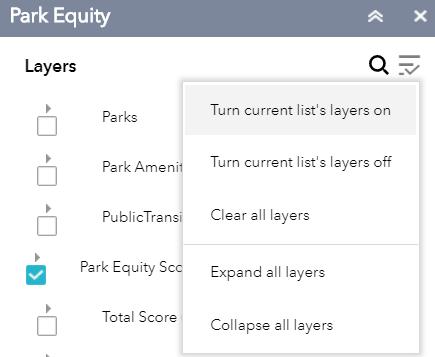 The Layer List widgets in the header at the top right allow you to switch layers. Layers are always drawn in order from top to bottom, and left to right, with the exception of the EJScreen context layers which will be drawn on top of any EJScreen layer. Keep in mind that the chart tool cannot be used while context layers are visible. Make sure to turn off all context layers before using the chart, either manually, or through the context menu's Clear All Layers button.To see layers in other groups, make sure to turn off any layers in the groups to the left of the desired layer. Viewing multiple layers at once is not recommended, as it makes it harder to visualize the data.
The Layer List widgets in the header at the top right allow you to switch layers. Layers are always drawn in order from top to bottom, and left to right, with the exception of the EJScreen context layers which will be drawn on top of any EJScreen layer. Keep in mind that the chart tool cannot be used while context layers are visible. Make sure to turn off all context layers before using the chart, either manually, or through the context menu's Clear All Layers button.To see layers in other groups, make sure to turn off any layers in the groups to the left of the desired layer. Viewing multiple layers at once is not recommended, as it makes it harder to visualize the data.
The context menu in the top right of each layer list allows you to turn all layers in the current list on or off, clear the layers of every list, and expand or collapse all the layers in the current list. Turning all of the layers of a layer list on at the same time is not recommended, as this can cause lists with many layers to fail to load. When a layer is turned on, it will automatically expand to show its legend. When it is turned off, the layer will be collapsed.
Accessing Block Group Data
Click on a block group to view the values of all the indicators in the top-most active layer for that block group. If you add a layer from a group that is higher in the drawing order while a block group is selected, it will automatically be re-selected in the new layer and and the info window will update to show the values of that group.
Tools
Select
![]() The select tool lets you draw a circle and select all of the block groups that at least partially fall inside. While you are drawing, the tool window shows the radius and area of the circle being drawn in miles and square miles. Once drawing is complete, the data for the selected features is automatically updated in the chart. To add more block groups to a selection, hold the shift key and draw a circle around them. Holding ctrl while selecting will remove block groups from the selection.
The select tool lets you draw a circle and select all of the block groups that at least partially fall inside. While you are drawing, the tool window shows the radius and area of the circle being drawn in miles and square miles. Once drawing is complete, the data for the selected features is automatically updated in the chart. To add more block groups to a selection, hold the shift key and draw a circle around them. Holding ctrl while selecting will remove block groups from the selection.
Chart
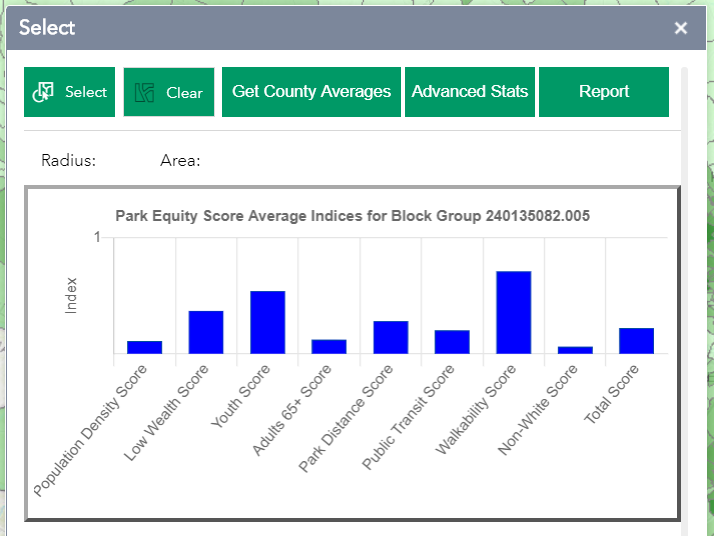 The chart helps you visualize the data. The default, simple chart shows the mean values for each indicator in the currently visible category for all selected block groups in a bar chart. If only one block group is selected,
the chart shows the actual values.
The chart helps you visualize the data. The default, simple chart shows the mean values for each indicator in the currently visible category for all selected block groups in a bar chart. If only one block group is selected,
the chart shows the actual values.
![]() Advanced Statistics
Advanced Statistics
The advanced statistics button switches the chart to a box-and-whiskers chart which lets you see the minimum, maximum, median, and 1st and 3rd quartiles. The box shows the range between the lowest 25% of values and the highest 25%. The middle line marks the median value. The top and bottom bars show the range of values that fall within 1.5 x the interquartile range. And data point above or below these values are considered outliers and are plotted as dots. Below the chart, these values, as well as the mean, range, and standard deviation, are listed for each indicator. Click on the labels below the chart to turn indicators on or off. If only one block group is selected, the advanced statistics will be the same as the simple.
![]() County Query
County Query
The "Get County Averages" button allows the user to view a chart showing statistics for an entire county. When a block group has been selected and this button is pressed, the app will automatically select every other census block group in the same county and update the chart with the new features. On the Simple Stats screen the chart will show the county data in red next to the selected feature's data. Click the button again to go back to viewing only the selected feature's data.
ReportThe Report tool creates a printable page showing the current map as well as a legend for the currently visible layer(s) and any selected feature. The chart and its data table will also be displayed on the printout, showing the number of selected features in each county as well as the mean value for each indicator in the layer. If the Report tool is called while the Advanced Statistics chart is displayed, these statistics will be shown on the report page as well.
 Print
Print
The Print tool creates a printable page showing the current map as well as a legend for the currently visible layer(s) and any selected feature. If multiple features have been selected, a table will also be displayed on the printout showing the number of selected features appearing in each county.
Side by Side Map Viewer
![]() This tool opens a new window with two identical maps of Maryland. Using the drop down menus, you can choose any two of the indicators from the app and compare them directly with each other. Any changes to the view of one map will automatically cause the other map to change to match.
This tool opens a new window with two identical maps of Maryland. Using the drop down menus, you can choose any two of the indicators from the app and compare them directly with each other. Any changes to the view of one map will automatically cause the other map to change to match.
In the settings window, you can change how the data is classified and the colors it is displayed in. To return to the main App, either close this tab or switch back to the other tab.
